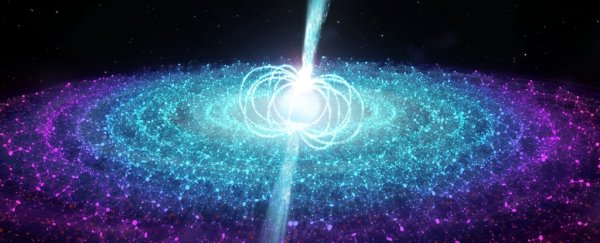Roughly 24,000 light-years away from Earth, in the constellation of Cassiopeia, is a dead star that shouldn't exist. Not, that is, according to current theory. The neutron star, accreting material from a much larger binary companion, is spewing out relativistic jets.
The problem is that it also has a strong magnetic field. And relativistic jets have only been observed in neutron stars with magnetic fields 1,000 times weaker.
So, our current understanding of how relativistic jets work simply doesn't account for this weirdo.
A neutron star is one evolutionary end point of a massive star that has gone supernova. Most of the star's material blows off into space while the core collapses in on itself, becoming a super-dense object with powerful gravity.
If it's under about three times the mass of the Sun, it becomes a neutron star, packing all that mass into an object just 10-20 kilometres across; if it's over that mass, it becomes a black hole.
That core collapse has a wicked effect on a neutron star's magnetic field - it "causes the star's magnetic field to increase in strength to several trillion times that of our own Sun, which then gradually weakens again over hundreds of thousands of years," said astronomer James Miller-Jones of Curtin University and the International Centre for Radio Astronomy Research (ICRAR).
Black holes are denser than neutron stars, famously with such powerful gravity that not even light can achieve escape velocity. Although not as strong, neutron stars also have a powerful gravitational field, which means they can accrete matter from other objects in their influence.
This is the case with the neutron star in this study. It's part of a binary system called Swift J0243.6+6124, discovered in October 2017 by the Swift Observatory, in which material from the star is being slurped up by the neutron star.
Jets are well known in the Universe - powerful streams of radiation and particles erupting at near light-speed from the poles of accreting objects.
"They are produced whenever matter falls onto a dense central object, from newly-forming stars to white dwarfs, neutron stars and black holes," Miller-Jones wrote for The Conversation.
"The one exception had been neutron stars with strong magnetic fields - around a trillion times stronger than that of the Sun."
We still don't know what powers these jets, but this glaring absence led to the theory that they could be constrained by powerful magnetic fields.
And then along comes Swift J0243.6+6124 to muck things up. The researchers, led by astronomer Jakob van den Eijnden of the University of Amsterdam, observed radio emission coming from the system, in addition to the X-ray emission spotted by Swift that led to the discovery.
After taking observations and analysing the data, they came to the conclusion that the radio emissions were consistent with relativistic jets from sources such as black holes - but, curiously, 100 times weaker than jets from other neutron stars.
"The radio spectrum of Swift J0243 is the same as that of jets from other sources and evolves in the same way," Van den Eijnden said. "The radio brightness also follows that of the in-falling gas, as seen in other jet-creating systems. So for the first time ever, we have observed a jet from a neutron star with a strong magnetic field."
And not just any old strong magnetic field. The magnetic field around Swift J0243.6+6124's neutron star is 10 trillion times stronger than that of the Sun.
This disproves the magnetic field theory about the suppression of jets quite neatly, and calls for a re-examination of how they are produced and launched, the researchers said.
Previously, it had been thought that neutron star jets were channelled from the magnetic field in the inner part of the accretion disc - and if the neutron star's magnetic field was strong enough, it would prevent the accretion disc from getting close enough for this to be triggered.
Except this new discovery kinda puts that theory in the bin.
It could be that, in some cases, the neutron star's rotational energy could be extracted to power the jets instead, Miller-Jones noted; this could explain why the jets were so weak compared to other neutron stars.
"Whatever the explanation, our result is a great example of how science works, with theories being developed, tested against observations and revised in light of new experimental results," he wrote.
"It also provides us with a new class of sources to test how magnetic fields affect the launching of jets, helping us to understand this key feedback mechanism in the universe."
The team's research has been published in the journal Nature.
